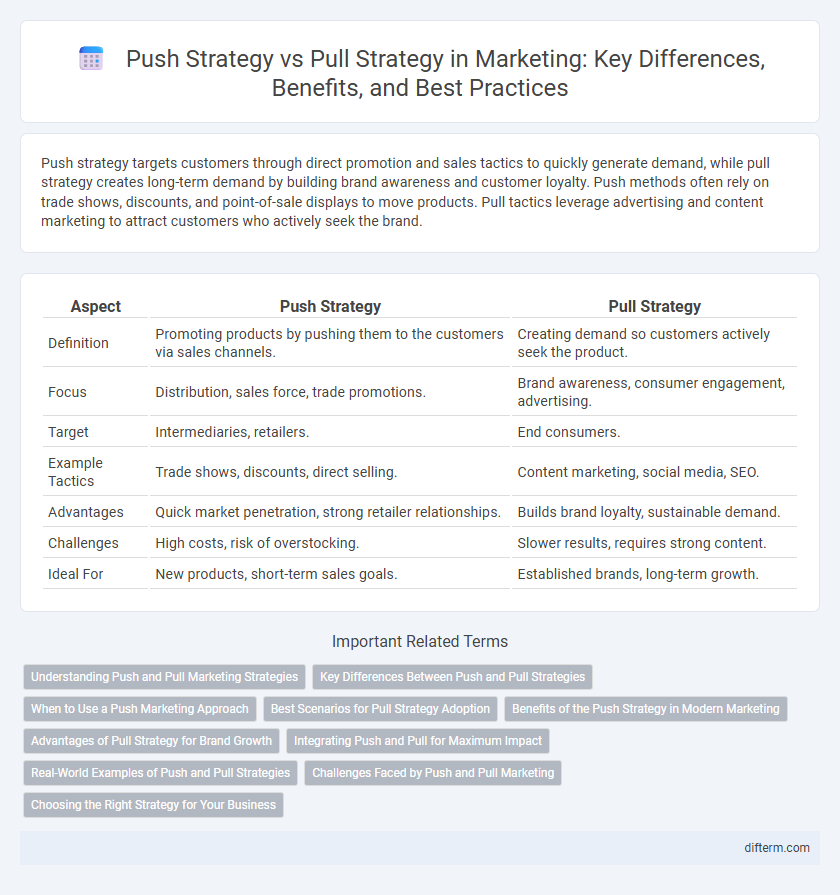Push strategy targets customers through direct promotion and sales tactics to quickly generate demand, while pull strategy creates long-term demand by building brand awareness and customer loyalty. Push methods often rely on trade shows, discounts, and point-of-sale displays to move products. Pull tactics leverage advertising and content marketing to attract customers who actively seek the brand.
Table of Comparison
| Aspect | Push Strategy | Pull Strategy |
|---|---|---|
| Definition | Promoting products by pushing them to the customers via sales channels. | Creating demand so customers actively seek the product. |
| Focus | Distribution, sales force, trade promotions. | Brand awareness, consumer engagement, advertising. |
| Target | Intermediaries, retailers. | End consumers. |
| Example Tactics | Trade shows, discounts, direct selling. | Content marketing, social media, SEO. |
| Advantages | Quick market penetration, strong retailer relationships. | Builds brand loyalty, sustainable demand. |
| Challenges | High costs, risk of overstocking. | Slower results, requires strong content. |
| Ideal For | New products, short-term sales goals. | Established brands, long-term growth. |
Understanding Push and Pull Marketing Strategies
Push marketing strategy involves actively promoting products through channels such as salesforce, trade promotions, and direct selling to ensure products reach consumers quickly. Pull marketing strategy creates consumer demand through advertising, content marketing, and brand loyalty efforts, encouraging customers to seek out products themselves. Companies often balance both by pushing products into distribution channels while pulling customers with targeted campaigns to optimize market reach.
Key Differences Between Push and Pull Strategies
Push strategy emphasizes actively promoting products through channels like direct sales and trade promotions to drive immediate customer purchases. Pull strategy focuses on creating strong consumer demand via advertising and brand loyalty, encouraging customers to seek products themselves. Key differences include the direction of promotion--push directs efforts toward intermediaries, while pull targets end consumers--and the timing of demand generation, with push aiming for quick sales and pull building long-term brand engagement.
When to Use a Push Marketing Approach
A push marketing approach is effective when launching new products or entering competitive markets where building immediate awareness is critical. It drives sales by actively promoting products through channels such as trade shows, direct selling, and retail displays to ensure quick availability. This strategy suits situations requiring rapid inventory turnover and strong control over the distribution process.
Best Scenarios for Pull Strategy Adoption
Pull strategy works best in highly competitive markets where brand loyalty and strong customer engagement drive demand. It is ideal for businesses launching innovative products or services that attract customers through effective content marketing and social media presence. Companies targeting tech-savvy, information-seeking consumers benefit most from pull strategies that emphasize brand awareness and long-term relationship building.
Benefits of the Push Strategy in Modern Marketing
Push strategy in modern marketing drives product visibility by directly promoting offerings to customers through sales force efforts, trade promotions, and point-of-sale displays, accelerating immediate purchase decisions. It enhances inventory turnover and market penetration by ensuring retailer and distributor support, creating a strong presence in physical and digital retail channels. This approach delivers measurable ROI quickly and supports brand awareness in competitive markets by placing products in front of consumers at critical buying moments.
Advantages of Pull Strategy for Brand Growth
Pull strategy drives consumer demand by creating strong brand affinity and emotional connections, fostering long-term customer loyalty and higher lifetime value. It leverages content marketing, social media engagement, and search engine optimization to attract targeted audiences organically, reducing reliance on expensive direct promotions. As a result, brands benefit from sustained growth through enhanced visibility, credibility, and consumer trust in competitive markets.
Integrating Push and Pull for Maximum Impact
Integrating push and pull strategies creates a powerful marketing approach that leverages the strengths of both methods to maximize customer engagement. Push strategies drive product awareness through direct promotions and sales efforts, while pull strategies generate demand by attracting consumers via content marketing and brand loyalty. Combining these tactics ensures comprehensive market coverage, enhancing brand visibility and accelerating the buyer's journey effectively.
Real-World Examples of Push and Pull Strategies
Brands like Coca-Cola effectively utilize pull strategies by creating strong consumer demand through emotional advertising campaigns and social media engagement. In contrast, companies such as Procter & Gamble implement push strategies by incentivizing retailers with discounts and in-store promotions to stock and prominently display their products. The automotive industry often combines both approaches, with brands like Toyota using pull marketing to attract customers through brand loyalty and push tactics to ensure dealer networks actively promote new models.
Challenges Faced by Push and Pull Marketing
Push marketing often struggles with low consumer engagement as it relies heavily on direct promotion through channels like sales teams and trade shows, which can lead to resistance or oversaturation. Pull marketing faces challenges in building strong brand presence and demand through content creation and social media, requiring significant time and resource investment before seeing measurable returns. Both strategies demand precise targeting and continuous adjustment to navigate changing consumer behaviors and market dynamics effectively.
Choosing the Right Strategy for Your Business
Selecting the appropriate marketing strategy depends on product type, target audience, and market conditions. Push strategies drive products directly to consumers through aggressive promotions and sales tactics, ideal for new product launches or impulse buys. Pull strategies stimulate consumer demand via branding and content marketing, effective for building brand loyalty and long-term customer engagement.
Push strategy vs pull strategy Infographic

 difterm.com
difterm.com